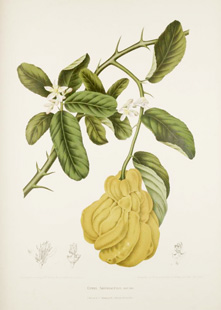Contorted Citron
By Audrey Stallsmith

Media brings pois'nous herbs, and the flat taste
Of the bless'd apple, than which ne'er was found
A help more present, when curs'd step-dames mix
Their mortal cups, to drive the Venom out:
'Tis a large tree, and like a bays in hue;
And, did it not such odours cast about,
'Twould be a bays; the leaves with no winds fall,
The flowers all excel: with these the Medes
Perfume their breaths, and cure old pursy men.
Virgil--"Georgics"
"Blessed apple" might be a peculiar description of what is probably the most frequently cursed ingredient in fruitcake! With its large, lumpy, and irregular shape, citron is the oldest--and also one of the oddest--fruits in the citrus clan.
Yet the Jews do consider it blessed, so much so that they use the Etrog type as the "boughs of goodly trees" required in their Feast of Tabernacles ceremony. (Leviticus 23:40) They also demand that the fruits be from ungrafted trees and perfect--or at least as perfect as citron can get!
Most growers in the U. S. have decided that it is just too much work to keep the fruits shaded, away from the tree's thorns, and otherwise protected from blemish. Citron is one of the more temperamental citrus types too, as it won't tolerate freezing temperatures and is inclined to sulk in less than perfectly drained soil.
Of course, Virgil may actually have had another fruit in mind, since the citron is not "a large tree," only growing to about 15 feet under the best conditions. Other ancients give similar descriptions of citron however.
Theoprhastus remarks on the "Median or Persian Apple" that "The fruit is not eaten, but is very fragrant, as is also the leaf of the tree; and the fruit is put among clothes, it keeps them from being moth-eaten. It is also useful when one has drunk deadly poison, for when it is administered in wine; it upsets the stomach and brings up the poison. It is also useful to improve the breath, for if one boils the inner part of the fruit in a dish or squeezes it into the mouth in some other medium, it makes the breath more pleasant."
He also describes the tree as having leaves like the arbutus and thorns like the wild pear, and bearing fruit in all seasons, which is an accurate description of the citron. Pliny reports that it is "held by some persons in particular dislike for its smell and remarkable bitterness; while, on the other hand, there are some who esteem it highly." Again, a very accurate description!
Pliny also mentions it being an antidote to poison, which could be why so many people thought it blessed. In his time, it was apparently grown in clay pots, with many holes drilled in them, probably to give the roots better drainage. But he concludes somewhat dispiritedly that "the tree will grow nowhere except in Media or Persia."
That's not entirely true, since some believe it originated in India, and it thrives there, as well as in other parts of Asia and the Mediterranean. Many citrus fanciers in colder climes also grow it indoors or in greenhouses. But, for such an ugly fruit, citron is somewhat exacting in its requirements!
It does inspire loyalty, however. In their ill-fated rebellion against the Romans, the Jews replaced Nero's image on their coins with one of the citron. Even the Romans themselves seem to have respected the tree, and may have constructed the first greenhouses to protect it.
The fruits are said to have an exceptional--and extremely strong--fragrance, reportedly including hints of violet as well as citrus. So they were often used to make pomanders. The flowers of the bitter types of citron are quite striking as well, with their white faces and purple backs, while blooms of the sweeter types tend toward a more yellowish hue.
The fruits also vary somewhat in shape--even on the same tree!, The one pictured above--Buddha's Hand--has fingers, while others look more like oversized and pimply lemons. Fruits intended to be candied for use in sweetbreads are harvested while still somewhat green.
Citron's colored outer skin, called the flavedo, isn't actually the only part used. The white inner pith or albedo can also be candied or made into jam. Koreans chop and sweeten the whole fruit to make a syrupy marmalade, which is then brewed into tea.
The tree's official name, Citrus medica, derives from the Latin cedrus ("apple of cedar"), for the resemblance the fruits supposedly bear to cedar cones. In fact, the Jews originally used cedar in their tabernacles ceremony.
The medica in the name actually refers to the Medes and not to medicine, but the fruit once treated a variety of physical problems. Besides being employed like ipecac--to expel poisons--and as a tonic, citron reportedly relieved indigestion, spasms, heart problems, diarrhea, rheumatism, and bad breath. It was also used to expel both phlegm and worms and as a sedative. Virgil's "pursy" can mean either "short-winded" or "fat," so the plant must have been thought to benefit old men who were either one or the other--or both!
In the Language of Flowers, citron stands for "ill-natured beauty" or "sadness." The former probably refers to the tree's thorns, the "sadness" perhaps to the fact that it can only produce misshapen pomes.
Citron was, however, the ancestor--or one of the ancestors anyhow--to all of the prettier citrus fruits we enjoy today. And it is, in my opinion, more interesting than any of them!
Citron medica image is from Fleurs, Fruits et Feuillages Choisis de L'ille de Java by B. H. Norton, courtesy of plantillustrations.com.








